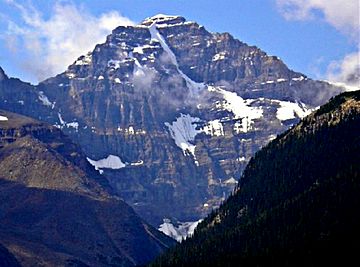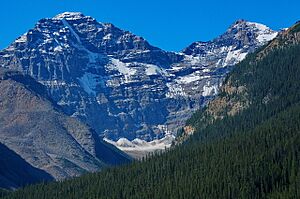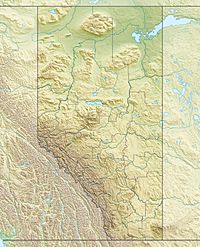Mount Cromwell facts for kids
Quick facts for kids Mount Cromwell |
|
|---|---|

Mt. Cromwell's north face from the Icefields Parkway in 2009
|
|
| Highest point | |
| Elevation | 3,330 m (10,930 ft) |
| Prominence | 330 m (1,080 ft) |
| Listing | List of mountains of Alberta |
| Geography | |
| Location | Alberta, Canada |
| Parent range | Winston Churchill Range |
| Topo map | NTS 83C/06 |
| Climbing | |
| First ascent | 1938 |
| Easiest route | rock/snow climb |

Mount Cromwell is a tall mountain found in the Sunwapta River Valley. It is located inside Jasper National Park in Alberta, Canada. This mountain stands about two kilometers north of the eastern top of Stutfield Peak.
The mountain was given its name in 1972 by J. Monroe Thorington. It was named after Oliver Eaton (Tony) Cromwell, an American climber. Tony Cromwell was known for being the first to climb many mountains in the Canadian Rockies.
Early Climbs and Explorers
The first time people successfully climbed to the top of Mount Cromwell was in 1938. The climbing team included E. Cromwell, E. Cromwell Jr., F.S. North, and J. Monroe Thorington. They were guided by Edward Feuz Jr., a very experienced mountain guide.
How Tall is Mount Cromwell?
For a long time, people thought Mount Cromwell was a bit shorter than 11,000 feet. But in 2005, Bill Corbett, an author who wrote a book about the highest mountains in the Canadian Rockies, climbed to the top. His book is called "The 11,000ers of the Canadian Rockies."
When Bill Corbett reached the summit, he used a GPS device. This device showed that the mountain was actually 11,006 feet tall! This new measurement means that Mount Cromwell might be added to the special list of Canadian Rocky Mountains that are over 11,000 feet high.
Mountain Weather: What's the Climate Like?
Mount Cromwell is located in a place with a subarctic climate. This means it has very cold winters with lots of snow. The summers are mild, which means they are not too hot.
Temperatures on the mountain can often drop below -20 degrees Celsius. With the wind, it can feel even colder, sometimes below -30 degrees Celsius. The snow and ice that melt from the mountain flow into the Athabasca River.


